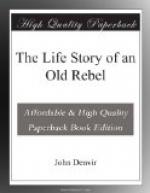Peter Maughan, who, like myself, was a house joiner, working at the Curragh, had similar experiences. Indeed, you might say that he was then qualifying himself for the part he very efficiently filled some years later in the Irish Revolutionary Brotherhood, as recruiting officer among the soldiery of Britain. Of course, he found scoundrels amongst them too, for, as the history of the Fenian movement shows, he was himself betrayed and sent to penal servitude.
Before I returned to England I had a most interesting tour through the South of Ireland, that being, I may say, the most I have ever actually seen of my own country. Having a taste for drawing, I took sketches of the various noted places I visited, which I preserved for many years—the most cherished remembrances of my visit to the “old sod.”
After returning from the Curragh to Liverpool, I married there and carried on business on my own account for several years as a joiner and builder, before taking service with Father Nugent, first as secretary of his Boy’s Refuge, and then as conductor for some three years of his newspaper, the “Northern Press and Catholic Times.”
CHAPTER VI.
THE IRISH REVOLUTIONARY BROTHERHOOD—ESCAPE OF JAMES STEPHENS—PROJECTED RAID ON CHESTER CASTLE—CORYDON THE INFORMER.
The trials in 1859, following the arrests in connection with the Phoenix movement, with which the name of Jeremiah O’Donovan (called also “Rossa,” after his native place) was identified, were the first public manifestations of what developed into the great organisation known in America as the Fenian Brotherhood, and, on this side of the Atlantic as the I.R.B., or Irish Revolutionary Brotherhood.
Many years afterwards “Rossa” called at the office of the Irish National League in London, to see his old fellow-conspirator, James Francis Xavier O’Brien, then General Secretary of the constitutional organisation for the attainment of “Home Rule.” As I was chief organiser for the League in Great Britain, and was in the, office at the time, I was introduced to his old comrade (who had, he said, often heard of me) by “J.F.X.,” as we used to call him, and it was to me a delightful experience to hear the two old warriors, who had done and suffered so much for Ireland, fighting their battles over again.
I was sitting in my office in Father Nugent’s Refuge one day, about the beginning of 1866, when my old friend, John Ryan, was shown in to me.
As we had not seen each other for several years, our greeting was a most cordial one. Though we had not met, I had heard of him from mutual friends from time to time as being actively connected with the physical force movement for the freedom of Ireland.
During this time I had often wished to see him, and I found that exactly the same idea had been in his mind regarding me; our object being the same—my initiation into the ranks of the Irish Revolutionary Brotherhood, of which he was an organiser.




